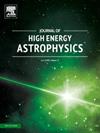Role of the complexity factor and Karmarkar condition in constructing new wormhole models in dRGT gravity
IF 10.2
4区 物理与天体物理
Q1 ASTRONOMY & ASTROPHYSICS
引用次数: 0
Abstract
This study delves into the distinctive characteristics of wormhole models in the context of de Rham-Gabadadze-Tolley (dRGT) massive gravity, providing insights into their theoretical behavior and stability. We use a null zero complexity factor to find the wormhole shape function for Model I. Additionally, we solve analytically the modified field equations describing wormhole for a given choice of logarithmic redshift function, exploiting the Karmarkar condition for embedding class one metrics for Model II. To achieve this, we analyze the wormhole geometry in a static spherical spacetime with an anisotropic matter configuration. The study investigates a number of parameters, including density, energy conditions, equation of state parameter, adiabatic sound velocity, and equilibrium condition. The solution shows a traversable wormhole that violates the null energy criterion and equilibrium state for certain ranges of free parameters. We employ adiabatic sound velocity analysis to concentrate on the stability of the wormhole. Furthermore, by using the equation of state parameter (ω), we conclude that both models end up in the phantom dark energy region. Finally, our findings highlight distinct photon deflection behaviors in dRTG massive gravity, with Model II showing negative angles indicative of repulsive gravity, while Model I exhibits positive angles, underscoring significant differences in gravitational dynamics.
复杂性因子和卡尔马卡条件在构建新的 dRGT 引力虫洞模型中的作用
本研究深入探讨了德拉姆-加巴德兹-托利(dRGT)大质量引力背景下虫洞模型的显著特征,为它们的理论行为和稳定性提供了见解。此外,我们还利用卡尔马卡条件(Karmarkar condition)为模型 II 嵌入一类度量,分析求解了在给定对数红移函数选择下描述虫洞的修正场方程。为此,我们分析了具有各向异性物质构型的静态球形时空中的虫洞几何。研究考察了一系列参数,包括密度、能量条件、状态方程参数、绝热声速和平衡条件。求解结果表明,在某些自由参数范围内,可穿越虫洞违反了空能量准则和平衡状态。我们采用绝热声速分析来集中研究虫洞的稳定性。此外,通过使用状态方程参数(ω),我们得出结论:这两个模型最终都进入了幻影暗能量区域。最后,我们的发现凸显了 dRTG 大质量引力中不同的光子偏转行为,模型 II 显示负角度,表明存在排斥引力,而模型 I 显示正角度,强调了引力动力学的显著差异。
本文章由计算机程序翻译,如有差异,请以英文原文为准。
求助全文
约1分钟内获得全文
求助全文
来源期刊

Journal of High Energy Astrophysics
Earth and Planetary Sciences-Space and Planetary Science
CiteScore
9.70
自引率
5.30%
发文量
38
审稿时长
65 days
期刊介绍:
The journal welcomes manuscripts on theoretical models, simulations, and observations of highly energetic astrophysical objects both in our Galaxy and beyond. Among those, black holes at all scales, neutron stars, pulsars and their nebula, binaries, novae and supernovae, their remnants, active galaxies, and clusters are just a few examples. The journal will consider research across the whole electromagnetic spectrum, as well as research using various messengers, such as gravitational waves or neutrinos. Effects of high-energy phenomena on cosmology and star-formation, results from dedicated surveys expanding the knowledge of extreme environments, and astrophysical implications of dark matter are also welcomed topics.
 求助内容:
求助内容: 应助结果提醒方式:
应助结果提醒方式:


